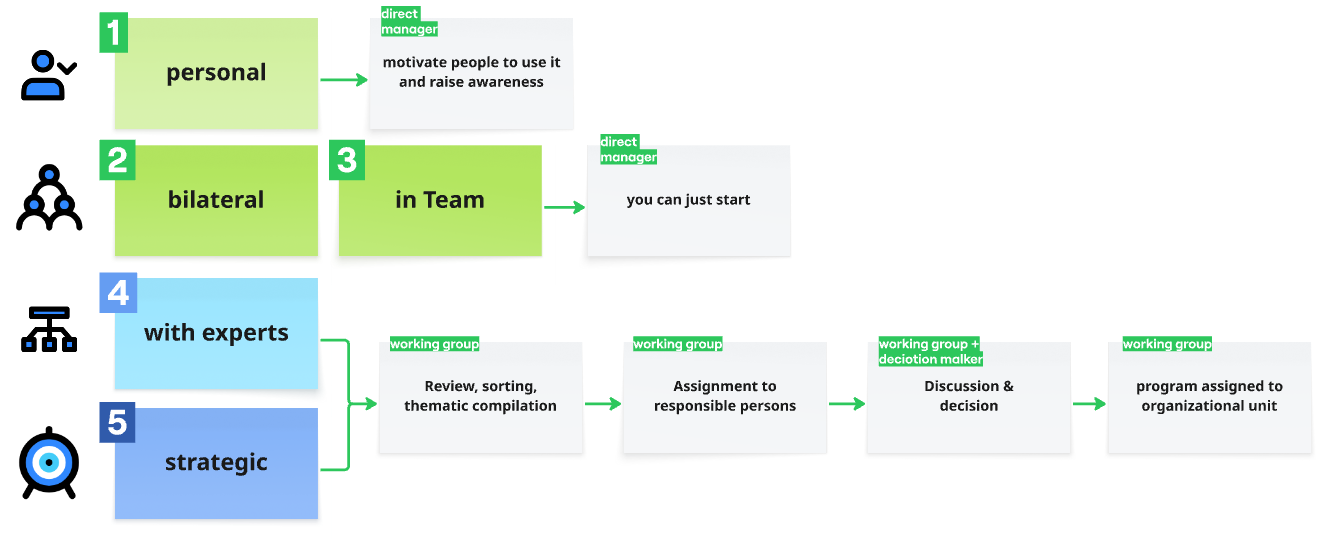Measure Types: Levels of Responsibility
Introduction
The clear distinction of measure types is central to effective hazard management. The operational responsibility for many measures lies with the direct manager (especially types 2 and 3), while technical interventions and structural decisions are controlled by the steering committee in coordination with the responsible departments (e.g., occupational safety specialists, occupational medicine, HR, management).
What do the measure types mean?
A detailed overview of measure types can be found on this page.
In the descriptions, you'll find hints like (Type 1, reactive) or (Type 4, preventive). This is a shorthand for the measures map that we use in the portal and manual:
 Figure: The five measure types with responsibilities and reactivity
Figure: The five measure types with responsibilities and reactivity
Reactive means: There is already a problem – the measure must help quickly and acutely (e.g., counseling after overload, moderation in acute conflict). Preventive means: The measure prevents problems and strengthens the system (e.g., training, team development, process improvements).
Example: (Type 2, reactive) = direct, situational measure between manager and employee as a response to an acute occasion.
Measure Types and Responsibilities
To systematically control measures, we distinguish five types. Each type has clear responsibilities:
| Type | What happens? | Who acts? |
|---|---|---|
| 1. Individual Measures (Employees) | Offers for health and social counseling, resilience programs, access to support. | Employees, Health Management |
| 2. Individual Measures (Manager ↔ Employee) | Individual conversations, absence conversations, individual agreements on stress. | Manager & Employees |
| 3. Team-related Measures | Team agreements, role clarity, feedback loops; strengthens the immediate system. | Manager & Team |
| 4. Expert-guided Measures | Technical interventions (occupational safety, IT solutions, occupational medicine), requires expert knowledge. | Experts (Occupational Safety Specialist, Occupational Physician, IT, external) |
| 5. Structural-systemic Measures | Governance, priorities, organizational structure, resource allocation; strategic decisions. | Board / Management / Department Heads / Steering Committee |
Note: The operational implementation of measures of types 2 and 3 lies primarily with the direct manager. Measures of types 4 and 5 are coordinated by the steering committee and decided and approved in coordination with the responsible departments.
Reactive vs. Preventive Measures
All five measure types can additionally be distinguished by reactivity:
Reactive
Damage or acute stress has already occurred (e.g., overload, escalating conflict). Reactive measures aim for quick protection, stabilization, and relief of those affected and usually need to be implemented short-term. Examples: Crisis counseling, moderation in escalated conflict, temporary work relief.
Preventive
Preventive measures target causes and systemic weaknesses before damage occurs. They promote lasting resilience, improve structures, and reduce the risk of future incidents. Examples: Leadership training, team development, process optimization, structural resource planning.
Important: Reactive measures are necessary for immediate protection, but do not replace systemic prevention. Both approaches need coordinated action.
Practical Guidelines for Control and Follow-up
- Documentation: Every measure in the portal should contain type, reactivity, responsibility, timeline, and success criteria.
- Escalation rules: When measures require type 4 or 5 or involve resource/organizational questions, a submission to the steering committee is to be sent.
- Responsibilities: Managers document implementation and follow-up for type 2/3; the steering committee monitors prioritization, budget approval, and implementation for type 4/5.
- Traceability: Measure planning and follow-up should be done so that requirements of ISO45003 and gda-psyche (phases of risk assessment) are traceably fulfilled.
- Time-critical response: In acute hazards, the manager immediately takes protective measures; in parallel, they inform the steering committee if technical or structural decisions are required.
Quick Check (Decision Template On-Site)
- Is it an acute, individual problem? → Type 2 (Manager ↔ Employee) — Manager acts immediately.
- Does it affect team dynamics or communication? → Type 3 — Manager moderates; possibly request external moderation.
- Does it require specialized expertise or legal/security decisions? → Type 4 — Involve experts / steering committee.
- Does it require structural changes or budget changes? → Type 5 — Steering committee / management decides.
- Is it purely individual support offers without organizational interventions? → Type 1 — Employees use offers directly.
Conclusion
The classification of a measure by type and reactivity is the key to efficient action: It makes responsibilities transparent, accelerates acute help, and ensures that long-term, preventive measures are systematically planned and financed.